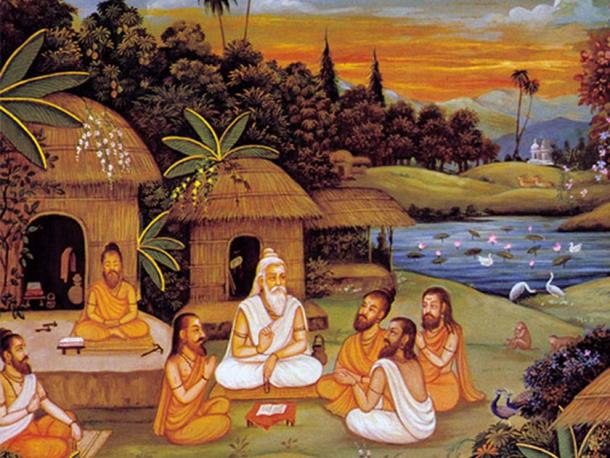 The ancient Indian scriptures are known collectively as the Vedas. The Bhagavad Gita comes from the Vedas. But what are the Vedas? The root vid means knowledge. According to the Hindus, the Vedas are holy scriptures. Any scripture that talks about the truth is a Veda. Another name for the Vedas is shruti, which means “that which is heard.” Sages “heard” these truths in their deep meditation. They didn’t read them somewhere or hear them from some other human being. They were not written by somebody and they have no historical date. That’s why the content of these shrutis is called the Sanatana Dharma or Eternal Truth.
The ancient Indian scriptures are known collectively as the Vedas. The Bhagavad Gita comes from the Vedas. But what are the Vedas? The root vid means knowledge. According to the Hindus, the Vedas are holy scriptures. Any scripture that talks about the truth is a Veda. Another name for the Vedas is shruti, which means “that which is heard.” Sages “heard” these truths in their deep meditation. They didn’t read them somewhere or hear them from some other human being. They were not written by somebody and they have no historical date. That’s why the content of these shrutis is called the Sanatana Dharma or Eternal Truth.
Even today in India this philosophy is known simply as Sanatana Dharma, and not as Hinduism. The word “Hindu” is incorrect. That label appeared only when foreigners came to India, saw a beautiful culture around the Indu Valley and started calling the people of that area “Indu.” Later it became “Hindus.”
It was “heard,” or you could say it has been revealed or realized. Such truth does not pertain just to India because truth has no limitation; it is cosmic. All those who go into a properly receptive state can get the same vision, or revelation. That’s why you see the same truth if you go to the very core of any religion. It will be expressed in a little different way, according to the age, the people and the geographical area. But the truth behind it all is the same. Whether it’s taught by Moses, Jesus, Buddha, Mohammed, Shankara or Krishna, they all had the same truth revealed to them.
Those revelations were passed on to their students. For this reason, the scriptures were called shrutis: the teachers said it and the students heard it. That is why the shrutis are called “Elutha Marai,” unwritten scriptures, in Tamil. After some time, as normally happens, the mental capabilities slowly eroded. Brain power grew duller and the energy weakened. The students weren’t able to retain it all by heart. They heard and could remember for some time, but slowly they began to forget.
It was then they started noting it down.
That’s how the Vedas came to be written. Until then, they were simply passed by word of mouth. That’s why, even today, if you read the original Vedas you’ll see they are like brief notes. Sometimes there are even incoherent parts. If you take notes while someone talks, only you can understand them. It was through their notes that the students passed on the teachings to their students—by expanding directly from the notes. And their students in turn took their own notes, and so on and on.
The Vedas cover the entire universe and all its activities. It does not talk only about something spiritual. There’s the theoretical wisdom part, and also the day to day side. The Vedas explain the different levels of life in the world: brahmacharya (the student or celibate); grihastha (the householder); vanaprastha (the recluse), and how each should live. They say how a marriage should be conducted, how rituals are to be performed—everything in day-to-day life is given.
The wisdom portion is the plain truth, the theoretical part. That’s also called Vedanta, Anta means end; Vedanta means the end or goal of the Vedas. This portion of the Vedas is also known as the Upanishads. The Upanishads say something directly about the final spiritual truth. But people found it difficult to grasp their meaning, so the great sage Vyasa (to whom the entire Vedas are ascribed), simplified it in his Brahma Sutras, teachings about the Absolute. Even the simplified sutraSy or threads, were a little difficult for people; so again they got diluted.
It’s something like giving medicine. If the patient finds it too difficult to swallow directly, coat it with sugar! Put the high philosophy into a nice story, the Mahabharata. The Bhagavad Gita, the Song of God, is a part of this story.
The Gita is the same Vedic truths presented as a story. Let us always remember that each religion has its Veda, The Koran is also Veda; the Bible is Veda, the Torah is Veda, the Dhammapada is Veda. Each is a veda because each is a revelation of the same cosmic truth.
If we want to learn something from a great scripture, we should approach it reverentially. Thus, we place ourselves in a receptive state.
Let us begin with a traditional prayer to the scripture:
OM, O Bhagavad Gita, by which Arjuna was illumined by Lord Krishna himself and which was composed of eighteen chapters within the Mahabharata by the ancient sage Vyasa;
O Divine Mother, Destroyer of rebirth, who showers the nectar of oneness on us; O Bhagavad Gita, my affectionate Mother, on Thee I meditate.
All the Upanishads are the cows, the milker is the cowherd boy, Krishna; Arjuna is the calf; people of purified intellect are the drinkers; the milk is the supreme nectar of the Gita,
My salutations to the Lord who is the source of supreme bliss, whose grace makes the mute eloquent and the crippled cross mountains.
This means that, with the grace of the supreme Lord, nothing is impossible.
Source: Excerpted from, The Living Gita: The Complete Bhagavad Gita by Sri Swami Satchidananda

